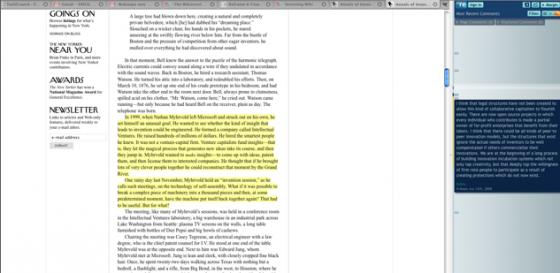
The idea of annotating the Web has been around for a long time. It goes back to a failed Web 1.0 startup called Third Voice. Today there are a handful of Web startups (Diigo, Fleck, Stickis, ShiftSpace, TrailFire) that let you mark up any Web page by adding virtual sticky notes or comments in a sidebar. One of these, ActiveWeave/Stickis, had to reboot as BlogRovr and eventually sold itself to BuzzLogic.
Now, a new startup that officially launches today, Reframe It, is trying its hand at the same game. The company has raised $700,000 from AD Gilhart & Co., and it boasts an impressive advisory board which includes Esther Dyson, Henry Louis Gates, Jr., and Howard Rheingold. (Dyson was also an angel investor in ActiveWeave). But it is not clear how Reframe It will distinguish itself from the other Web annotation startups that have so far failed to spark a lot of interest among users.
Reframe It is a browser plug-in for Firefox or Internet Explorer that lets you highlight passages of text on a Web page and add your own comments in a side pane. Comment can be private, public, or visible only to certain groups. Anyone with the Reframe It plug-in can then see those comments in their side pane as they browse the Web. Reframe It also has a Twitter-like social feature that lets you follow other people’s comments, as well as comments within groups. You can follow these comments in an RSS feed, which you can track in your blog reader or other services such as FriendFeed. To help get you started, Reframe It allows you to import your contacts from Gmail, Facebook, and (soon) LinkedIn and other services.
The service itself does a decent job of letting you markup the Web and read other members’ comments in context. The problem, as with all of the similar services that have come before it, is that the chances of coming across a Web page that has Reframe It comments is pretty small. So the side pane (which at least is collapsible) will be pretty useless for most people. The comments also are slow to load. It might appeal to heavy commenters, however.
But even there, disassociating comments from the pages where they appear is not always a good thing. Comments are becoming such an integral part of most Web pages (especially on blogs and media sites) that the best way to ensure the most people will read a comment is to add it directly to the page through each site’s commenting system. ReFrame It comments are only visible to other people who have added Reframe It to their browsers.
That is not to say that there is no value in extracting comments and republishing them as original content. In fact, some comment systems such as Disqus aim to do something similar by treating each commenter as an author and collecting their comments across all sites that use Disqus. Similarly, the ability to comment on links collected in FriendFeed or Facebook help to elevate and highlight the comments themselves. But the reason these discussions are interesting in their own right is because they are occurring among your friends or people you care about. What FriendFeed has shown also is that you don’t need to comment on the Web page itself. All you really need is the link.
